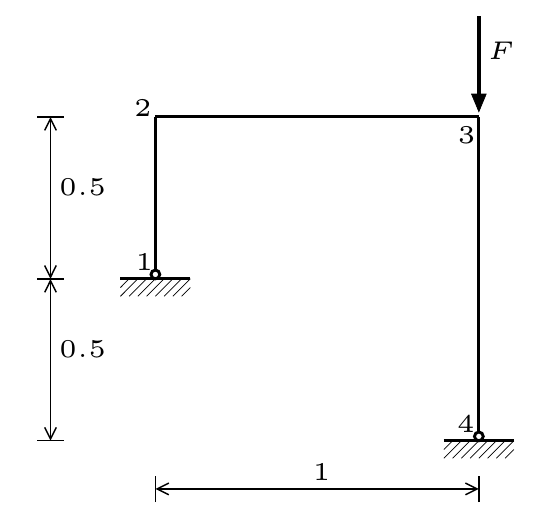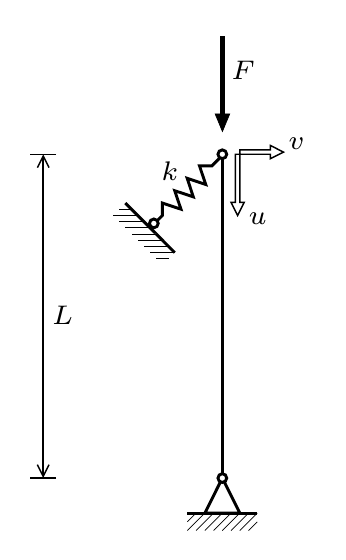PyJive workshop: buckling#
This workshop is about analysis of buckling problems with pyjive. Two different modules are applied, the LinBuckModule for linear buckling analysis and the NonlinModule for incrementally-iterative geometrically nonlinear analysis. The main model that is used is the FrameModel.
import matplotlib.pyplot as plt
import numpy as np
import os
import sys
pyjivepath = '../../../pyjive/'
sys.path.append(pyjivepath)
if not os.path.isfile(pyjivepath + 'utils/proputils.py'):
print('\n\n**pyjive cannot be found, adapt "pyjivepath" above or move notebook to appropriate folder**\n\n')
raise Exception('pyjive not found')
from utils import proputils as pu
import main
from names import GlobNames as gn
%matplotlib widget
import contextlib
from urllib.request import urlretrieve
def findfile(fname):
url = "https://gitlab.tudelft.nl/cm/public/drive/-/raw/main/buckling/" + fname + "?inline=false"
if not os.path.isfile(fname):
print(f"Downloading {fname}...")
urlretrieve(url, fname)
1. Euler Beam#
As a first example, Euler buckling is considered.

findfile("beam.geom")
findfile("eulerLB.pro")
findfile("eulerNonlin.pro")
Task 1a: Linear buckling analysis
Look in the code to find out how the
LinBuckModuleand theFrameModelinteract. Twoscipylinear algebra functions are used,spsolveandeig. What is the function of each of these?Run linear buckling analysis with the cell below. Print the first 5 buckling values (they are stored in a sorted array in
globdatwith the keygn.LBFACTORS).Compare the obtained values to the analytical solution \(F=n^2\pi^2EI/L^2\). What can be done to bring the results closer to the theoretical ones?
props = pu.parse_file('eulerLB.pro')
globdat = main.jive(props)
Task 1b: Geometrically nonlinear analysis
Run the cell below, and inspect the results.
What is the difference between the inputs for the two
main.jivecalls? How does this affect the model results?Is the analysis performed in load control or in displacement control?
props = pu.parse_file('eulerNonlin.pro')
globdat = main.jive(props)
props['model']['neum']['values'] = '[ 0.001 ]'
globdat = main.jive(props)
2. Frame buckling#
As a next example, the buckling behavior of a simple frame is analyzed.

findfile("frame.geom")
findfile("frameLB.pro")
findfile("frameNonlin.pro")
Task 2: Frame buckling
Run the two analyses types by executing the two cells below.
How well do the different analyses agree?
Why does the nonlinear analysis not require an imperfection this time to find buckling behavior?
props = pu.parse_file('frameLB.pro')
globdat = main.jive(props)
print(globdat[gn.LBFACTORS][0:5])
props = pu.parse_file('frameNonlin.pro')
globdat = main.jive(props)
3. Imperfection sensitivity#
The final case concerns analysis of a column that is supported by an inclined elastic spring.

An input file is provided where the spring is modeled with a separate FrameModel, with \(EI=GA=0\) and a value for \(EA\) that ensures \(k=1\).
findfile("inclined.geom")
findfile("inclined.pro")
Task 3: Imperfection sensitivity
Inspect the input file
inclined.pro. Can you figure out how different properties are assigned to different parts of the model?Check the influence of moving the top node with an imperfection of \(\Delta=L/100\) to the right. How does this affect the maximum load carrying capacity?
What happens if the imperfection is introduced by moving the top node the same distance to the left?
props = pu.parse_file('inclined.pro')
globdat = main.jive(props)
